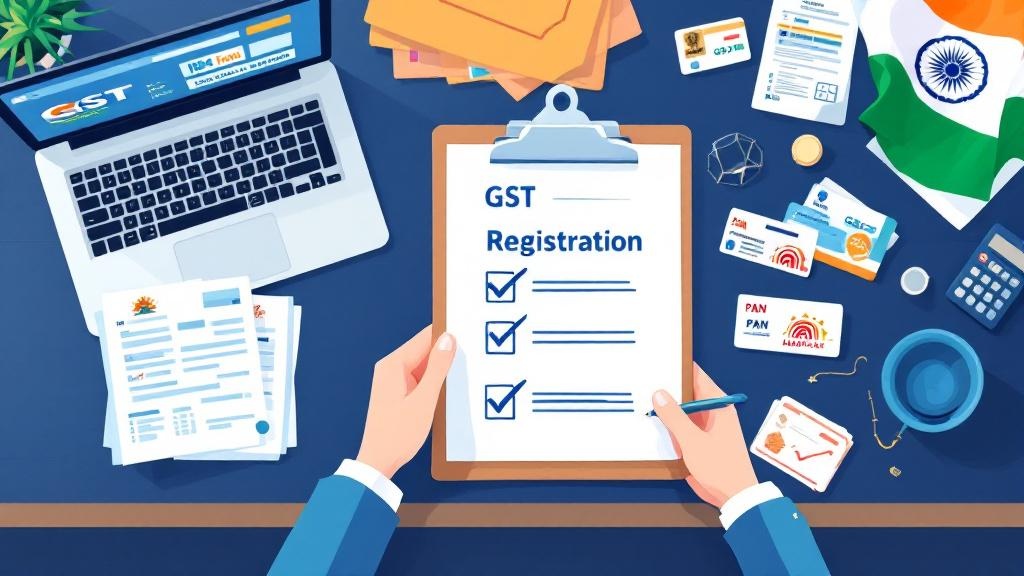If you’re starting a business or expanding your operations in India, getting registered under the Goods and Services Tax (GST) is an essential legal step. Whether you’re a small startup, an online seller, or a seasoned entrepreneur, navigating the GST registration process can be confusing at first. That’s why having a clear and complete checklist makes all the difference.
In this blog post, we break down everything you need to know about GST registration in India—who needs it, how to apply, and a detailed checklist to make the process hassle-free.
What is GST Registration?
GST (Goods and Services Tax) is a unified indirect tax system in India, introduced in 2017 to replace multiple cascading taxes levied by the central and state governments. Businesses that exceed a certain turnover threshold or fall under specific categories are required to register under GST.
Simply put, GST registration gives your business a unique GSTIN (Goods and Services Tax Identification Number) that allows you to collect tax from customers and claim input tax credits.
👉 If you want to simplify your GST registration process, you can start your application here with professional support.
Who Needs to Register for GST?
Here’s a quick overview of businesses that must register under GST:
-
Turnover-based registration:
-
₹20 lakhs for service providers (₹10 lakhs in special category states)
-
₹40 lakhs for goods suppliers (₹20 lakhs in special category states)
-
-
Mandatory registration regardless of turnover:
-
Interstate suppliers
-
E-commerce sellers
-
Agents of suppliers
-
Input service distributors
-
Businesses under reverse charge mechanism
-
Non-resident taxable persons
-
Online data access or retrieval service providers from outside India
-
Benefits of GST Registration
Before we jump into the checklist, it’s worth knowing the benefits:
-
Legal recognition of your business
-
Ability to collect GST from customers
-
Input tax credit on purchases
-
Better business credibility
-
Required for e-commerce platforms like Amazon, Flipkart
Documents Required for GST Registration
The documentation is one of the most crucial parts of GST registration. Here’s a document checklist based on your business type:
✅ For Sole Proprietorship/Individual
-
PAN card of the owner
-
Aadhaar card
-
Passport-sized photograph
-
Business address proof (electricity bill, rent agreement)
-
Bank account statement or canceled cheque
✅ For Partnership Firm / LLP
-
PAN cards of the firm and partners
-
Aadhaar cards of partners
-
Passport-sized photographs
-
Partnership deed or LLP agreement
-
Address proof of principal place of business
-
Bank account details
✅ For Private Limited Company / Public Limited Company
-
Company’s PAN card
-
Certificate of incorporation
-
MOA & AOA
-
PAN and Aadhaar of directors
-
Board resolution authorizing a director for signing
-
Business address proof
-
Bank details
Checklist for GST Registration Process in India
Now let’s walk through the step-by-step GST registration checklist. Following this will ensure that you don’t miss any important details and avoid delays or rejections.
1. ✅ Verify Eligibility
-
Check if your turnover exceeds the threshold limit.
-
Identify if your business falls under mandatory registration.
-
Ensure you have the proper business structure (proprietor, partnership, company, etc.)
2. ✅ Collect All Necessary Documents
-
Refer to the document list above and scan them for online upload.
-
Make sure all documents are clear and updated.
3. ✅ Create a GST Portal Account
-
Visit the official GST portal: www.gst.gov.in
-
Click on ‘Services’ > ‘Registration’ > ‘New Registration’
-
Fill in basic details like legal name, PAN, email, and mobile number.
4. ✅ Verify OTPs & Temporary Reference Number (TRN)
-
You will receive two OTPs (one on email and one on mobile).
-
After verification, a TRN will be generated. This is required to proceed further.
5. ✅ Complete the GST REG-01 Form
-
Log in using your TRN.
-
Fill in business details: name, constitution, location, jurisdiction, etc.
-
Add authorized signatory details.
-
Upload all required documents.
-
Add principal and additional place(s) of business.
-
Specify goods/services your business deals in (use correct HSN/SAC codes).
-
Add bank account details (optional during initial registration, but must be added within 45 days of approval).
6. ✅ Digital Signature (DSC) or E-Sign
-
For companies and LLPs, a Digital Signature Certificate (DSC) is mandatory.
-
Others can use Aadhaar-based OTP e-sign.
7. ✅ ARN Generation
-
After successful submission, you will receive an Application Reference Number (ARN).
-
Use this ARN to track the status of your application.
8. ✅ Application Review by GST Officer
-
If everything is in order, the GST officer approves the application within 7 working days.
-
If any clarification or additional documents are required, you’ll receive a notice (Form GST REG-03).
-
You must respond within 7 days using Form GST REG-04.
9. ✅ Receive GSTIN and Certificate
-
Once approved, your GSTIN is generated and sent via email and SMS.
-
You can download the GST registration certificate from the portal.
-
Display the certificate at your place of business.
Common Mistakes to Avoid During GST Registration
Avoiding small errors can save you time and re-application efforts:
-
Using mismatched details (PAN name vs application name)
-
Uploading blurred or incorrect documents
-
Selecting the wrong business type or jurisdiction
-
Not responding to officer notices within deadlines
-
Missing DSC for companies or LLPs
Post-GST Registration Compliance Checklist
Your responsibilities don’t end with registration. Here are a few compliance tips post-registration:
-
File monthly/quarterly GST returns (GSTR-1, GSTR-3B, GSTR-9, etc.)
-
Maintain accurate invoices and sales records
-
Regularly reconcile ITC claims
-
Update GST registration in case of changes (address, business structure)
-
Display your GSTIN at your place of business
How Long Does GST Registration Take?
Typically, GST registration takes 7–10 working days if all documents are correct and there are no queries from the GST officer. However, delays can occur if clarification is sought or documents are unclear.
Tips for a Smooth GST Registration Experience
-
Keep scanned copies of all documents in the recommended format (PDF/JPG).
-
Double-check all entries before submission.
-
Keep your PAN and Aadhaar details handy for instant verifications.
-
Use professional help if unsure—this can speed up the process and avoid errors.
Final Thoughts
Registering under GST is not just a legal requirement—it enhances your business credibility, helps you expand legally, and allows for smoother operations with vendors and clients.
Having a clear GST registration checklist makes the process more organized and stress-free. Whether you’re registering for the first time or helping someone else, following the steps above ensures you stay on the right track.
Ready to get started with your GST registration?
You can apply easily online here with expert support and hassle-free processing.






Comments (0)